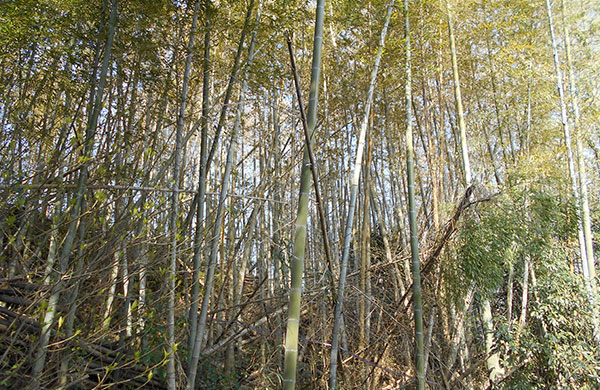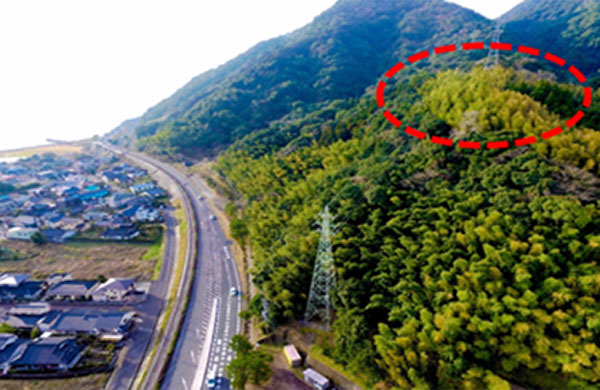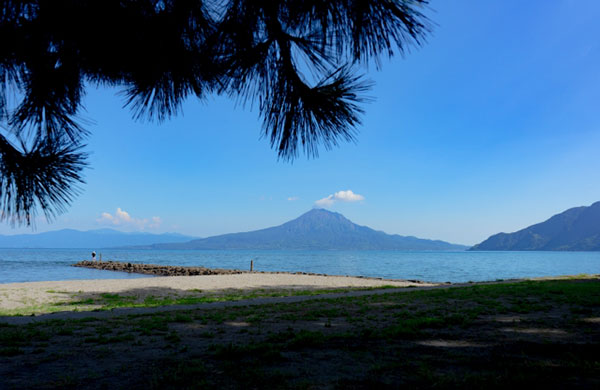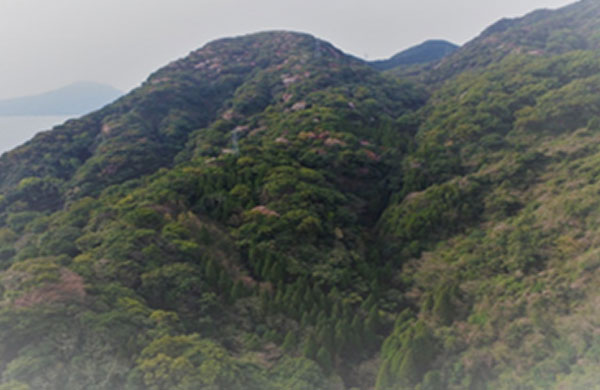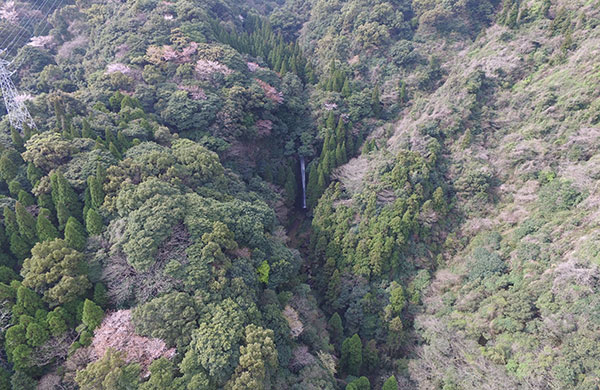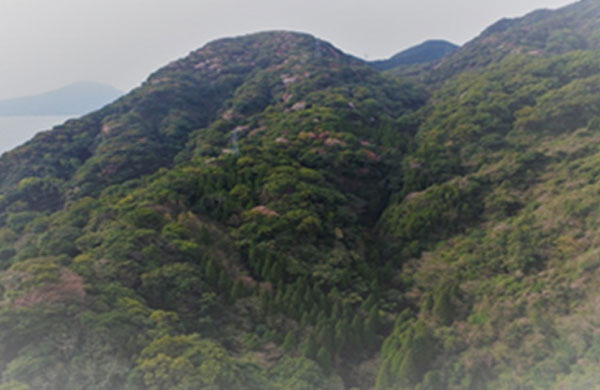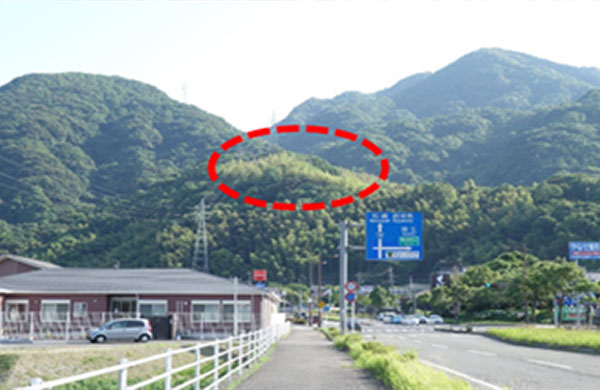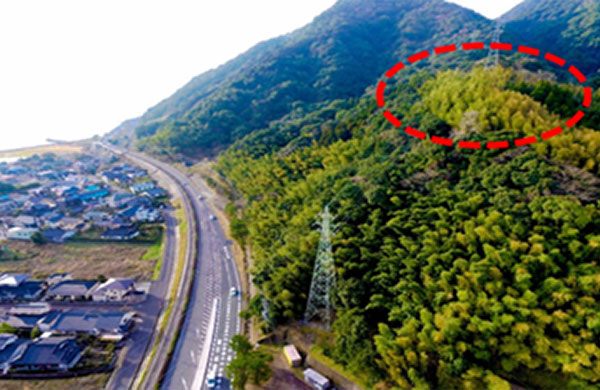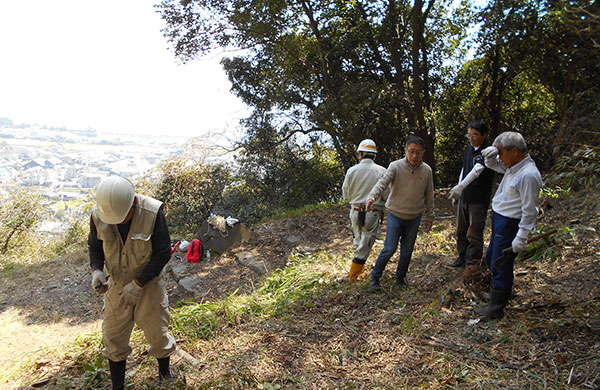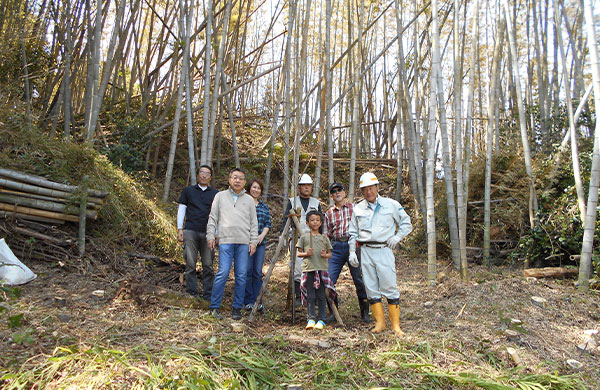About Shigetomi Environmental Conservation Club
Shigetomi Environmental Conservation Club was established on November 29, 2016, with the aim of restoring the mountains in the Shigetomi Wakimoto area, focusing on Shirakanezaka, as natural forests adapted to their original environment.
The Shigetomi Wakimoto area is a historic place associated with the Shimazu family, and there are many valuable heritage sites that provide visitors with a sense of Kagoshima's history. The Shigetomi Forest has seen the changes in Shigetomi area over the years.
The Shigetomi Environmental Conservation Club revives the rich forests of the Shigetomi area by assessing their condition, zoning activities, cutting down non-native plants in the secured forests, and planting mountain cherry trees.
Along with environmental issues, such as global warming and ozone layer depletion, the invasion of non-native plants in the natural world is also a major concern.
The awareness of forest conservation is growing within the prefecture, and this is evident in the encouragement of agreements with companies on corporate forestation that nurtures the environment as a part of their CSR activities. To preserve the rich forests for future generations, the Shigetomi Environmental Conservation Club is still active in this area, as demonstrated by activities like cutting down Moso bamboo in 2019.
Original nature lost
ーInvasive Natural Forests
Shigetomi forest used to be full of beautiful natural trees, but it has now lost its original appearance because of the invasion of non-native species.
While a well-maintained summit area retains its scenic beauty, the area from the foot to the middle of the mountain has been devastated owing to the neglect of bamboo forests and extensive growth of Moso bamboo, a non-native species.
In addition to Moso bamboo, the presence of other invasive alien plants, such as Chayote and Japanese Knotweed has been confirmed. If this trend continues, many natural forests may be lost to the invasion of non-native species.
The overgrowth of bamboo, particularly Moso bamboo, which thrives in the Shigetomi forest, has also caused landslides and driftwood damage in recent years. Natural forests, which are increasingly invaded by non-native species, are known to protect the local people from disasters.
ーInvasive Alien Species
Non-native species are organisms that are not originally and naturally grown in an area, but have been introduced from other areas due to human activities. The problem with invasive alien species is deep-rooted; many non-native plant and animal species have been identified in the prefecture. While the major focus is on animals, such as the Mongoose and Black Bass, invasive plant species also cause a variety of problems that impact the ecosystem.
The proliferation of neglected non-native species not only degrades the landscape but also prevents the growth of native and endemic species that originally inhabited the area, resulting in the loss of the beauty of old-growth forests. Other invasive alien species also affect human life, or cause damage to agriculture, forestry, and fisheries. It is essential to adhere to the three principles of invasive species prevention: "do not introduce," "do not discard," and "do not spread," to help solve the problem of invasive species proliferating in various parts of Japan.
Historic and Beautiful Shigetomi
ーShigetomi's Original Nature
The Shigetomi district of Aira City has a magnificent view that overlooks Sakurajima and Kinko Bay. In 2012, the tideland adjacent to Shigetomi Beach was designated as a national park due to its rich natural environment.
The beautiful ocean that spans the Shigetomi coast is protected by the richness of Shigetomi Forest. Shigetomi Forest was originally a bountiful place inhabited by a wide variety of flora and fauna. The coexistence of plants and animals, and the nutrients produced by the trees flowed from the river to the ocean providing energy for marine life. There is a Japanese saying, ”the forest nurtures the sea”, and Shigetomi's forests have protected and nurtured the beautiful shallows along the Shigetomi coast.
ーShigetomi as a Transportation Hub
The Shigetomi area was once an important transportation hub, as was the land around the port and train station. Shirakanezaka, which was used as a road to the castle during the Warring States period, and Wakimoto-ura, as a port for ships, which was the center of traffic and trade, are located in this area. Shigetomi Station, one of the oldest stations in the prefecture, was established in the middle of the Meiji period. Shigetomi has prospered as a transportation hub since ancient times and is steeped in Kagoshima's history.
【Shirakanezaka】
During the Edo period, the Satsuma clan ignored the directives of the Shogunate and established its own defense network, known as the outer castle system. Samurai villages, called fumoto were constructed in various regions around their domain. It is said that warriors who were going to the castle from these outlying villages climbed the hill via Shirakanezaka, which was a major roadway. At that time, Shirakanezaka was the border between the Osumi and Satsuma domains, and it is said that warlords set up camps on this slope during the Warring States period.
It is also said that the castle was accessed by boat from the port of Wakimoto-ura at the foot of the hill to avoid the difficult climb up the Shirakanezaka slope.
【Wakimoto-ura】
During the Edo period, Wakimoto-ura was a port for vessels of various sizes, mainly for transportation and trade. It was also the entrance to Shirakanezaka and greeted people crossing the bay from the Osumi Peninsula - a thriving transportation hub for the Satsuma clan. The Shigetomi Offshore, which can be seen from Wakimoto-ura, is also the site of the beginning of the Anglo-Satsuma War. The Anglo-Satsuma War began with the Namamugi Incident, and was a battle between the Satsuma clan and the British Royal Navy. The British fleet was visiting Shigetomi to negotiate compensation for the Namamugi Incident and surrounded a steamer that was turning around at Wakimoto-ura, capturing Godai Tomoatsu and Terashima Munenori, who were in command of the steamer. The Satsuma Clan regarded this action as an attack from the British and began bombarding the area, and the sea seen from Wakimoto-ura became the scene of a short but intense battle.
Wakimoto-ura not only supported its people's daily lives by serving as a trading port at the end of Kagoshima Bay but was also the first fort to intercept the British fleet that attacked Satsuma.
【Shigetomi Station】
Japan's first railroad was officially inaugurated in 1872 between Shimbashi and Yokohama stations in Tokyo. In Kyushu, the first railroad line was opened in 1889 between Hakata Station and a temporary station at Chitosegawa. In 1895, the Nippo Main Line began operating between Kokura and Yoshiwara stations, and the line was subsequently extended to various locations across Kyushu. In Kagoshima prefecture, the first railroad line opened between Kagoshima and Kokubu Stations (now Hayato Station) in 1901. Shigetomi Station was one of the first four stations (Kagoshima Station, Shigetomi Station, Kajiki Station, and Kokubu Station), and railroad users came from as far away as Miyakonojo and Kamo. The town continued to prosper as a short-distance transportation hub, connecting the surrounding areas by horse-drawn carriages. Shigetomi Station, which is still used as a boarding and alighting point for JR users, is one of the oldest stations in the prefecture, and overlooks the Shigetomi area.
Preserving Nature for the Next Generation
At a time when environmental issues are discussed on a global scale, it has become imperative that we restore the original natural environment that was protected by our ancestors and has supported life in the Shigetomi region since ancient times. In recent years, a natural forest restoration project has been undertaken at Shiroyama Park in Kagoshima City, where rare species have been protected by cutting down non-native species. Protecting the richness of nature with the help of local people not only preserves the beauty of the landscape but also ensures the safety of the surrounding residents by preventing landslides.
Nurturing lush forests will also lead to the realization of carbon neutrality, a goal that is being pursued worldwide. Afforestation and thinning can increase the absorption of carbon dioxide.
To achieve carbon neutrality, it is important to protect abundant natural forests.
"We want to restore beautiful natural forests and leave rich forests for the future."
"We intend to restore the beautiful natural forests of the Shigetomi region and leave a rich natural legacy for the future."
To realize this goal, we will continue to engage in the natural reforestation of the Shigetomi region.
Past Activities
Relationship with the SDGs
The Shigetomi region is home to a beautiful natural forest which is highly important for the maintenance of the local biosphere. Shigetomi was an important cultural and transportation center during the Edo period, and still has many natural heritage sites that must be preserved for the future. It is important to protect natural forests that have been neglected and suffered the negative effects of invasive species. This can be achieved by planting miscellaneous trees that are compatible with the original natural environment and restoring the original landscape of the mountains. Shigetomi's tidal flats are composed of properly managed mountains. Our organization is working to maintain the richness of the sea and mountains, and to realize the goal of a sustainable society.

- Inclusive, Safe, Resilient, and Sustainable Cities:
- 11.4
We will work to preserve the natural environment through efforts to maintain the forests and mountains. - 11.a
We will work to restore natural forests, carry out conservation activities, ensure continuing preservation by future generations.

- Conserving Oceans and Marine Resources for Sustainable Development:
- 14.1
By regenerating Shigetomi forest, we will prevent disasters, such as landslides and driftwood damage, and protect the richness of the sea.

- Managing Forests Sustainably, Preventing and Reversing Land Degradation, and Halting Biodiversity Loss:
- 15.2
We intend to to protect native species by cutting down non-native species and promoting and restoring the growth of native forests. - 15.4
By regenerating natural forests, we strive to maintain the original biodiversity found in the Shigetomi region.
